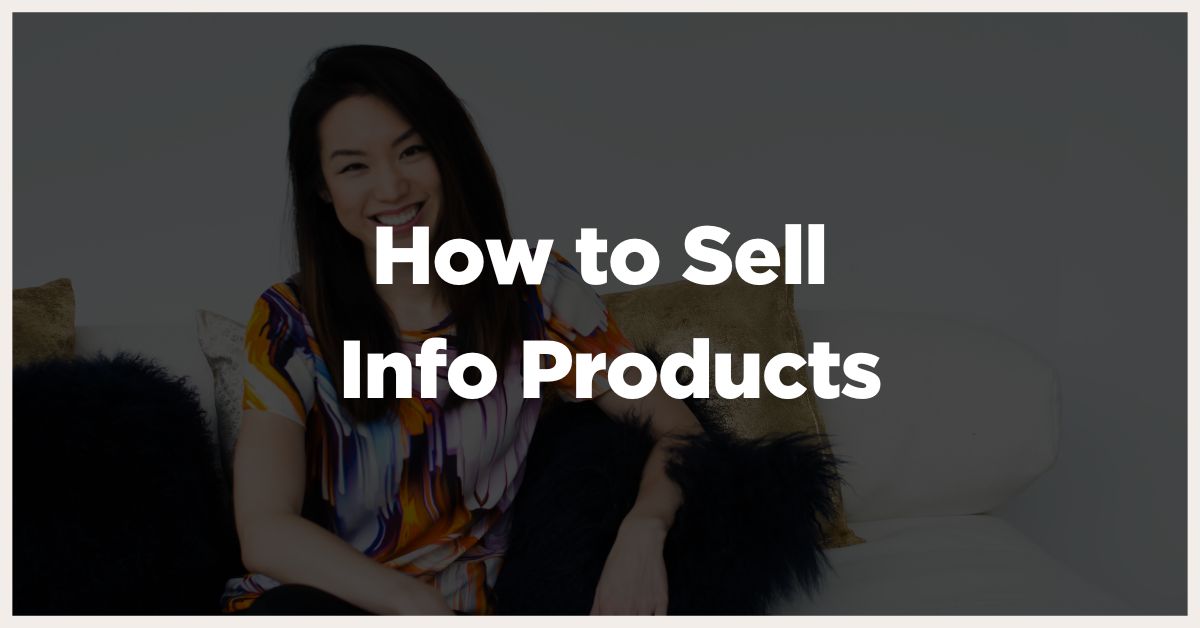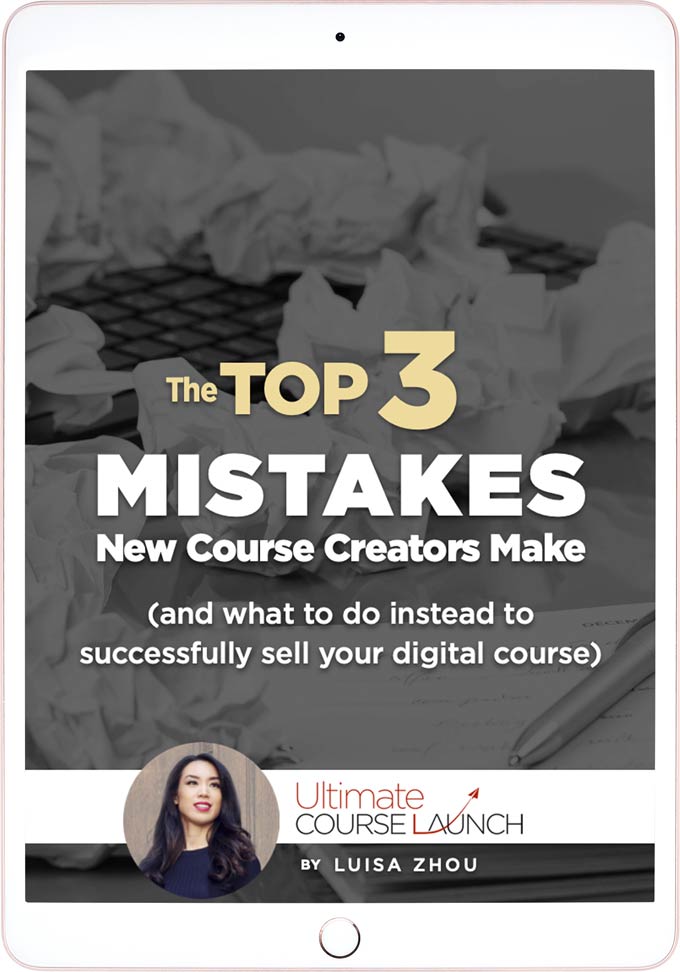Want to learn how to sell information products? (Or, “info products.”)
Then, you’re in the right place. Today, you’ll learn all about selling information products in a way that creates real value and builds a truly profitable business that supports you and your clients.
Want to learn more? Read on!
What does it mean to sell information products?
First, let’s take a look at what info products are… and why they’re one of the best business models out there. Here’s what you need to know.
What are information products?
Info products are digital products, including online courses, e-books, and workbooks or templates.
The thing you sell is information. Just a few examples include teaching people how to code, how to get a promotion, or how to get toned abs.
Because some information is highly sought-after, your info product can be a high-ticket, premium offer. However, this depends on the type of information product you sell… which we’ll look at next.
What are examples of information products?
There are various types of info products. These include:
- Online courses. You typically sell online courses either on your own website or on an online course platform like Teachable. Online courses can sell for $50-$2,000 or even more. You can also sell online courses on marketplaces like Udemy. In that case, you’re more restricted with your pricing. Udemy offers a big audience, but as courses typically sell for $10, it’s not necessarily the best way to build a profitable business.
- Ebooks. Ebooks are usually priced relatively low, between $10-$50. You can sell these on your own website, Teachable or a marketplace like Etsy or Amazon.
- PDFs. PDFs are, like ebooks, typically priced low and they sell for between $10-$50. Just like ebooks, PDFs can be sold on your own website, Teachable, Etsy, or Amazon.
What are the benefits of selling information products online?
But why should you sell info products?
First of all, info products are in demand. The e-learning industry is expected to grow to over $243 billion this year. Not to mention that in 2020, course creators on Teachable earned $456.7 million and Udemy has 40 million users.
With info products, you can create an amazingly flexible schedule, build a massively profitable business, and create a big and lasting impact.
You can also use info products to build an extra income stream. If you’re offering services, such as coaching or consulting, online courses are a great addition to those offerings.
And finally, online courses are scalable. They don’t require you to create new products, but you can sell the same asset over and over using scalable marketing strategies like search engine optimization and advertising.
So that you can build a true Freedom Business that doesn’t rely on YOU, that is based on the lifestyle you want (not the other way around), and that is a scalable system that continues to grow your business every day, independent of your “hustle.”
But what are some examples of info products? That’s what we’ll find out next.
What information products sell best?
The best info product business to start is, hands down, an online course business. That’s because online courses are the most profitable info product. While you need to sell 10 online courses at $1,000/course to make $10,000, you’d need to sell 200 ebooks or PDFs at $50 to make the same amount of money.
A common myth is that it’s easier to sell low-priced products. Selling your course actually has very little to do with the price.
You can sell whatever you want, no matter what industry you’re in, what price you want to charge, or anything else you think might be stopping you, if you know how to craft and position your offer in a way that’s attractive to your ideal clients.
You also need to understand what makes your offer so unique and attractive, have a sales strategy that works, and be clear on the value you offer that you’re able to sell with 1,000% confidence.
Off the top of my head, here are just a few industries I’ve helped clients make 6- to 7-figures in…
…Energy healing
…Book writing
…Relationship attachment styles
…Confidence
…Parenting
…Leadership
…Mindset
…Animation
…Health
…Organization
…Beauty
And at various price points (everything from $7 products to $10,000+ offers).
Here’s a bit more about what it takes to reach 6-figures in your business:
But how do you ultimately sell your info products? Here’s what you need to know.
How do you sell information products?
The principle I’ve used and my students have used to build 6- and 7-figure businesses is straightforward:
Create the best product and make sure that the people who want them (aka want the solution it provides), know about it.
You first need to find a niche that you can be fairly certain will be successful. You also need to create your product in the right way, and, finally, package and sell it. We’ll look at these steps next.
Discover the top 3 reasons most courses fail
(plus how to fix them so you succeed)
How to decide on your information product niche
The first step is to find a niche for your offer.
A niche is a segment of the overall market. For instance, if you’re a health coach and your audience consists of women over 40, that’s your niche.
Your niche will help you stand out from all the other businesses out there. You’ll be able to ask for higher rates because you’re so specific with who you serve.
And if you want to be known for other things, too, you can. Start with one niche and then expand to other areas.
Steps to choosing a niche
Brainstorm all the categories you could potentially niche down to depending on your skills and experience. For instance, when I started out, a few niches I could’ve built a business were Excel consulting, career coaching, and digital advertising.
Then, identify who you can help on that topic who is willing and able to pay for your course. Next, figure out what you help them with.
And finally, answer the question: why you? How do you help people get faster, better, or easier results?
You can condense these steps into this sentence:
“I help (who) get (what) by (why you).”
For example:
“I help ambitious, mid-career women get ahead faster by showing you how to focus on the right jobs & projects that will advance your career.”
In this short video, I talk more about finding a niche:
Examples of successful course niches
But what are some examples of successful course niches?
Here are a few examples to help you get started:
- Health courses (nutritional planning, weight loss, allergy treatment, fitness courses, strength training, meal planning, running, and yoga)
- Career courses (salary negotiation, leadership, promotions, resume writing, job interviewing, career change, and finding a dream job)
- Business courses (website building, branding, sales funnel creation, social media, email marketing, copywriting, conversion optimization, PR, and selling)
- Arts and crafts courses (painting, knitting, calligraphy, pottery, sketching, sewing, crocheting, furniture restoration, illustrating, and woodwork)
- Personal finance courses (real estate investing, personal finance, planning for retirement, house rentals, investing, family financial planning, and money management)
- Relationship courses (dating, online dating, communication, LGBT, religious groups, breakup recovery, and managing family relationships)
- Personal development courses (speaking, social skills, stress management, networking, productivity, energy healing, happiness, spirituality, mindset, and creativity)
How to find an audience for your info products
In 2008, Kevin Kelly published his 1,000 True Fans concept.
Maybe you’ve heard of it. Because since then, it’s been widely quoted.
Rightfully so too. Because the idea—that 1,000 true fans are all you need to make a living—is so powerful and true.
When I first heard it, it completely changed my thinking.
It made me realize I needed to think smaller.
Not just about the millions of people I wanted to eventually help, but about the first actual 1,000 clients whose lives I was going to transform.
So I became obsessed with finding those first 1,000 people.
Which was completely different from my previous thinking of trying to just grow as big of an audience as possible. (AKA how most audience-building advice teaches you, wrongly, to think.)
Look at it this way:
What if instead of trying to get 1,000 email subscribers and make 10 sales, which is the norm, you only needed to get 50 subscribers to get those 10 sales? Doesn’t that feel so much…better?
It certainly makes it more doable. But how do you get those 50 subscribers? Let’s take a look.
How do you build your audience?
Want to know the “secret” to building an audience?
I don’t have one! Because it’s not about having a secret strategy or list-building tip that no one knows. (Although yes, it’s important to have the right strategy for your business and goals.)
It’s about the little details that make a big difference when implementing the right strategies.
For example, does it matter if you post five times on social media every day (since according to the “experts,” that’s a surefire way to grow your audience) BUT you aren’t posting in the right places? Or you aren’t posting the right content? Or you aren’t saying it in a way that connects with people?
It all comes down to this:
The way you implement your strategy makes ALL the difference. So don’t look for a “silver bullet” strategy. Focus on one strategy and implement THAT strategy well.
Discover the top 3 reasons most courses fail
(plus how to fix them so you succeed)
What strategies should you use to grow your audience?
But what strategies can you use to grow your audience?
There are various strategies, both easy and more advanced.
Start with one or two of the easy strategies and once you’ve mastered those, you can move on to the advanced strategies.
Easy strategies
- Podcasting and guest posting. When you guest post, you post on other sites with an existing audience. Similarly, podcasting means that you get interviewed on a podcast and get in front of that audience.
- Social media. Use a social media platform where your audience hangs out to connect with your audience.
- Joint ventures. A joint venture is a partnership with people who have similar audiences. You can either cross-promote your products or in other ways partner to promote your courses.
Advanced strategies
- Digital advertising. Facebook, YouTube, TikTok and Instagram ads can be effective for scaling your business. They do come with a learning curve, though.
- Search engine optimization. SEO is another scalable marketing strategy. It takes time to learn and to build your SEO efforts, so I don’t recommend this strategy for new course creators.
How to create digital information products
The next step is to create your digital product. You see, selling information products comes down to creating great products.
But how do you do it? Here’s how to create digital info products that sell.
Sell your course before you create it
Want to know what one of the biggest mistakes new course creators make?
It’s to create their course before they sell it. That’s right.
They create their course first because they think it’s “higher value.” And that’s holding them from making any sales because they aren’t creating something their customers actually want.
That’s why you should launch a small part of your program first, like the first module. Once you have paying clients, you create the rest of the course.
You obviously also need the course outline so that you and your students know what’s in the course.
Once you have a few students enrolled in your course, create each module one at a time by using your student feedback. That way, you create something that your audience really wants.
Start with a “First Steps” course
Another mistake many course creators make is to start by creating their magnum opus, a course so detailed and comprehensive that it’s the “best” course on the market.
However, this is not what you should do.
Instead, start with a First Steps course.
This is a course that teaches your students the first steps of the ultimate goal you’re able to help them with.
So for example, if you’re a health coach who helps people drop 50 pounds, your First Steps course would help them drop 10 pounds.
Not only is it much easier to create a First Steps course, it’s also easier to sell. So you don’t have to be overwhelmed or try to get it “perfect” before you sell it.
Add on coaching or consulting
A great way to add value to your course is to offer coaching or consulting with it. Offer either group coaching calls, private coaching calls, or Q&A sessions where you answer questions from the past month or week.
The benefit? Your courses become easier to sell AND you help your students get faster results.
How to choose a price for your information product
Before you sell your course, you need to decide on a pricing structure for it.
But how do you set a premium price for your product?
The thing is that it’s not actually about the pricing. No one is going to keep themselves from buying something if it’s a few dollars cheaper.
The same principle applies to your course pricing.
When you’re selling a transformation that they deeply want (not just something they kind of want), then the pricing doesn’t matter that much, as long as it’s in the range of what they can afford.
And when someone buys a course, it’s not just for the result your course helps them with. They also buy it because of YOU. Your unique take, your experiences, stories, way of thinking about and of doing that particular thing.
What I usually recommend is that my students start with a First Steps course that they price at around $500.
A good price point for your bigger course (the one you’ll create later on) is around $2,000. (However, this depends on the value of your course and if you pair it with coaching or consulting services.)
Down the line, you can definitely optimize your pricing and test different price points, but it’s not something you should be spending time on when you’re just starting out and you’re figuring out your audience and offer.
How to market your information products
Something I see new course creators do is to set up a website, build an email list, and after some time, create a course and try to sell it to their audience. Often, that way doesn’t work out so well.
You see, the best way to sell your courses depends on where you are in your business—including your skills, reputation, audience size, and business model. Ultimately though, nothing beats human connection for making the most sales.
And when you’re just starting out, you likely don’t have very strong marketing or copywriting skills.
That’s why I usually recommend a specific launch strategy for new-ish course creators.
A launch strategy helps you build that human connection without requiring you to be an incredibly talented marketer, so that you can have big course sales before you have a complicated sales funnel. Here’s how!
Your launch strategy
The strategy I usually recommend if you’re starting out is a four-part strategy.
First, you pre-launch where you build an audience with the goal of selling your course. So you might be dropping hints about your course and talking about it.
Second, you have your launch trigger, an event that triggers your product launch. This could be a webinar, a challenge, or a combination of them.
Then, you open your launch. During this time, you send daily emails, post daily social media posts, send emails to people you think would be interested, and so on.
After that, you go into your post launch. Now, you’ll focus on creating a great experience for your clients.
In this short video, I share more about marketing your course:
Your course funnel
Ultimately, when you’ve successfully sold your course using launches, you can proceed to create a webinar funnel where you direct traffic (from your email list, social media, advertising, and other marketing strategies) to automatically make sales.
This funnel consists of a webinar, emails, and a sales page.
Your webinar is all about introducing people to your course. With your emails, you then engage them even more. And your sales page is helping them make the decision to buy (or not).
When you start driving traffic to your funnel through strategies like digital advertising and search engine optimization, that’s when you have a course that essentially will sell itself and needs minimal effort on your part.
It takes work to get there (it took me several years to make “passive income”), but with the steps I’ve laid out above, you get to enjoy running a highly profitable business right from the start that you can eventually turn into a machine that runs on its own with minimal input from your side.
Over to you!
There you have it! Selling information products can be a highly profitable business model. Ultimately, it’s a business that can offer you freedom, flexibility, and impact.
Discover the top 3 reasons most courses fail
(plus how to fix them so you succeed)
Want to learn more about how to create YOUR online course?
Get my free PDF that reveals what 3 deathly mistakes most new course creators make.
Learn more:










One Response
hey Just a question. Do you possibly know the profit margins for the average info product businesses? Just doing some research!
Thank you,
Jostin